Handling and Transporting Sturgeons
Some tips and advice for netting, handling and transporting sturgeons.

Handling a Pallid Sturgeon (Scaphirhnchus albus)
Netting Sturgeons
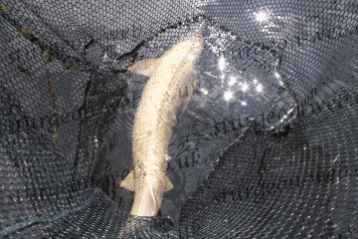
Small sturgeons are pretty easy and straight forward to net, in some cases they can be literally picked out of the water by hand if near the edge but some care must be taken as the scutes on small sturgeon can be quite pointed and sharp, especially with small Diamonds.![]()
Beware with larger fish, sturgeons can get very big and heavy and can be very strong so make sure you have a suitable sized and strength net and a container large enough to put them in. If they are going to be in the container for more than a few minutes it should be aerated.![]()
Sturgeons can also be much longer than the depth of even the biggest nets so approach the sturgeon headfirst and slightly from below where you think it's swimming path will be. The sturgeon's forward motion should allow it to enter the net easily.![]()
I tend to have the net at a angle rather than vertical, this helps hold the net body open as I want the fish to swim in as I move the net upwards and toward the fish rather than snatching at it.![]()
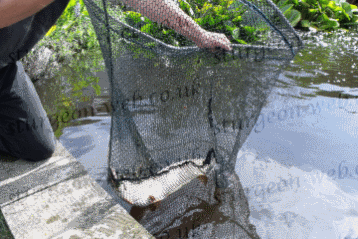
Sturgeons aren't as net-shy as most fish and they don't have very moveable pectoral fins like other pond fish have, so they can't rotate the pectoral fins vertically in the water to brake forward motion or reverse paddle out of trouble.![]()
Trying to net sturgeons from behind can spook the normally sedate swimming fish into a very fast flight reflex away from the net and can make you very wet if they are near the surface, as their large tail fins can displace a lot of water as they power away from you.![]()
With larger fish make sure the head travels to the deepest part of the net so most of the heavy body section is well supported by the netting while you manipulate it to the container.![]()
If you are lifting the sturgeon out of the pond in the net, grasp where the handle meets the net with one hand and place the other hand on the net rim opposite the handle, this will stop the net bending and reduce the chance of the fish flicking itself out of the net.![]()
Be careful when lifting larger fish as they can be very heavy and can also slap you in the face with their tails.

Holding a small sturgeon for a photo, keep you hands around the fish for a few moments until it settles, then open the hands a little to show the fish better for the photo
Handling Sturgeons
Smaller and medium size fish can be moved in the net or container if it is big enough to hold them comfortably. Containers should have just enough water to cover the gill plates to cut down on the weight while moving.![]()
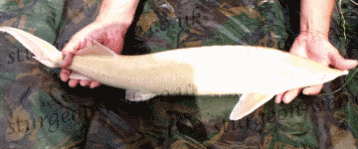
Albino Sterlet (Acipenser ruthenus) on a wet carp unhooking mat
Alternatively, a carp sack or weight sling can be used, even a wet towel held at both end with the fish running the length of it makes a good makeshift sling, bunch the ends to stop forward or backward movement and make sure the pectoral fins aren't at odd angles to the body.
Koi socks can be used but make sure the ring is big enough for the fish and pectorals to enter and exit easily.![]()
For really big fish over 1.2m (4ft) I tend to use an old bed sheet in the same way as the towel once the fish is netted and brought to the side of the pond the wetted bed sheet can be wrapped around the fish then lifted slowly at first to make sure it is secure and to let most of the water drain before lifting (the fish can be heavy enough by itself without carrying water around as well).![]()
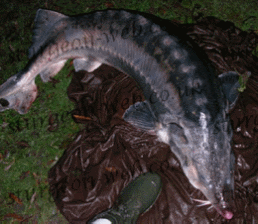
4 year old 38kg 1.65m long Beluga Sturgeon (Huso huso) on the wet sheet that was used as a sling to carry the fish from the transport tank to the pond
If you are confident in holding fish you can carry the fish by hand for short movements between bowls and ponds. Hands should be wet and extra care taken with sterlets as they can produce a lot of mucus when netted and stressed so can be quite slippery to hold. ![]()
The main way to hold sturgeon between 30cm (1ft) to 90cm (3ft) is by grasping firmly but not to tightly around the caudal wrist with one hand and the other hand supporting the pectoral area and head it is best if the head is towards your body that way if it does start to struggle you can use your arms and body to steady it.![]()
If it continues to struggle you can sometimes hold the fish in one hand around the caudal wrist with the body hanging vertically downwards this can stop the fish struggling but it is safer to put it down on a wet padded surface upside down on it's back as this can have the same effect.![]()
Never touch sturgeon with dry hands or place on dry or warm / hot surfaces. Sturgeons should never be placed on hard surfaces such as paving slabs, concrete or timber.![]()
Use a wetted carp mat or, at the very least, a wet towel. Never put a fish on loose surfaces, wet or dry. Wet grass, not bare earth can be used for a short period but it's not ideal.
If you are putting the fish down for any reason, close supervision of the fish is a must. It is no good being even 5 ft away if the fish starts to struggle or flap around.![]()

a wet towel used as an improvised sling
Transporting Sturgeons
Big strong bags are a must for even the smallest fish as you want as much oxygen in the bag as possible for the journey, this is most important on hot days in the summer but its true all year round. Even small fish should be at least double bagged as the scutes can puncture or rip the strongest grade bags, triple bagged is better for longer journeys or fish over a foot in length.![]()
For longer journeys it is also worth asking the shop for a couple of spare bags just in case you spring a leak on the way. On long journeys check on the fish a couple of times to make sure it hasn't ripped the bag. It is best if the bags are in a box to stop them rolling around and the dark will help keep the fish calm. During summer on the back seat in an air conditioned car is much better than to boot to help keep it cool. As with koi it is best to sit the bag/box widthways in the vehicle so that the fish isn't sloshing backwards and forwards every time you brake and accelerate and you should take cornering steady for the same reason.![]()
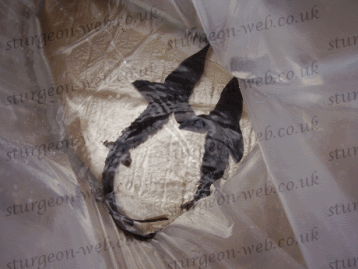
A couple of small Siberian Sturgeons (Acipenser baerii) being unpacked from the box and bag
When bagging small fish, add only as much water as needed to cover the fish. With bigger fish, add just enough water to cover the gills when laid flat, leaving more space for air and cutting down on the weight (a 3-4ft bag with 4-5" of water in is pretty heavy).![]()
Fill the bag with oxygen, or air from an air pump should be ok for short journeys as long as it isn't too hot. Do not over fill the bag, a tight bag has more chance of splitting if knocked, but so it is quite full and still gives a bit if some pressure is applied. If collecting more than a few small fish it is better to split them into more bags and boxes than you would with koi.![]()
Fish larger than 3 ft are best carried in a large covered tank to stop them jumping and to stop water splashing as fish this size can shred bags very easily. Run some air stones into the tank with an air pump running from an suitable power inverter plugged into the vehicle's cigarette lighter socket. It is also worth having some hydrogen peroxide or other oxygen booster handy in case of emergencies, if your car breaks down on the way home for example.![]()
The best way is to collect the fish yourself but if you have to order for overnight delivery here's a few things to keep in mind; As sturgeon can takes drops in water temperature very well it is best to cool the fish down to 10°C to increase the oxygen saturation in the water. Specify a before 10:00 am delivery and also don't have them sent out over night if the nigh time temperatures would be very high (over 20°C). It is better to wait a few days for a break in the weather than have a overly stressed, or worse dead fish, arrive. Fortunately this is very rare but it can happen.![]()
Written by Terry White
Contents
Home
Sturgeon Species
Sturgeon Care
Sturgeon Health
Water Quality
Our Other Sites

Copyright © 2000-2024
www.sturgeon-web.co.uk
All Rights Reserved.
Protected by UK Copyright Service Registration No:311386
